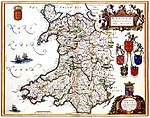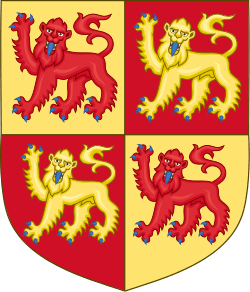Norman invasion of Wales
The Norman invasion of Wales began shortly after the Norman conquest of England under William the Conqueror, who believed England to be his birthright. Initially (1067–1081), the invasion of Wales was not undertaken with the fervour and purpose of the invasion of England. However, a much stronger Norman invasion began in 1081 and by 1094 most of Wales was under the control of William's eldest son, King William II of England. The Welsh greatly disliked the "gratuitously cruel"[1] Normans and by 1101 had regained control of the greater part of their country under the long reign of King Gruffudd ap Cynan, who had been imprisoned by the Normans for twelve years before his escape. Gruffudd had some indirect help from King Magnus III of Norway (Magnus Barefoot) who attacked the Normans briefly off the Isle of Anglesey in northwest Wales near Ynys Seiriol, killing Hugh of Montgomery, 2nd Earl of Shrewsbury and leaving the Normans depleted and demoralized. Magnus went on to take the Orkney Islands, the Hebrides, and the Isle of Man, islands north of Wales and west and north of Scotland and England, in 1098.
Part of a series on the |
|---|
| History of Wales |
 |
|
Chronology |
|
|
Under William's fourth son, King Henry I of England, the Normans, now well established in England, responded by pushing west into Wales. This time, both the Welsh and the Normans were more interested in making peace than fighting bloody battles, and a relatively stable situation developed, although the Normans fared worse in southeast Wales than in the west of the country. The standoff continued from 1135 to 1154 under Stephen, King of the English, nephew of Henry and a maternal grandson of William, who became locked in a power struggle and civil war with Empress Matilda, Henry's daughter and only surviving legitimate child.
By the 1150s, Matilda's son King Henry II of England had set upon fighting back, leading his first expedition into Wales in 1157. He met with heavy and humiliating defeat, particularly in the Battle of Ewloe at Coleshill / Coed Eulo, where Henry was entirely unsuccessful and was almost killed in the fighting, his army routed and fleeing. He moved against his British adversaries again in 1163. Later sources related how he gained an unclear form of homage from the two most powerful princes of Wales, Rhys ap Gruffydd and Owain Gwynedd, along with the king of Scotland. This was the catalyst to revolt in Wales; Henry II met with humiliating defeat in 1165 at the Battle of Crogen by the Berwyn range. Henry never successfully invaded Wales and he was obliged to seek compromise with Rhys ap Gruffydd for control of the south.
Welsh attacks in England
By the mid-11th century, Wales had been united by the Prince of Gwynedd, Gruffudd ap Llywelyn. Gruffudd pushed into Saxon England, burning the city of Hereford, overwhelming border patrols, and proving the English entirely inadequate to respond to Welsh invasions.[2] During this time, Harold Godwinson led a campaign of raids which dented the authority in Wales.[3] In the wake of this campaign, Gruffudd was turned upon by his own men, who killed him in 1063 and shipped his head off to Edward the Confessor in exchange for the redivision of Wales into its traditional kingdoms.[4] This left a vacuum of power in Wales in which princes and kings were free to squabble over their lands, without the unifying presence of Gruffudd to ward off Norman attacks.
Early battles
It took some time for the Normans to concentrate any level of might against the Welsh, however, as they were more concerned, in the aftermath of Hastings, with England and Normandy.[5] In addition, it was not William’s goal to conquer Wales; he had come to inherit what he believed to be his birthright, the English throne, which entailed taking on the responsibilities of Edward and the Anglo-Saxon kings, including their relationships with Wales and Scotland. However, Wales had begun to force the matter, supporting English rebellions against the Normans.
William's response
In response to Welsh advances, William established a series of earldoms in the borderlands, specifically at Chester, under Hugh d'Avranches; Shrewsbury, under Roger de Montgomerie; and Hereford, under William FitzOsbern. He instilled a great deal of power into each earldom, allowing them control of the surrounding towns and land, rather than retaining it within the kingship. The inspiration for such an action seems to have been the overextended nature of the Norman troops, thus preventing William from exercising his own power in the area.[6] It very well may have been implicit in the power granted the earldoms that they were to attack Wales, and, indeed, they did, beginning with south-east Wales, where many of the previous rebellions against England had begun. By the time of FitzOsbern's death in 1071, a castle had been established at the mouth of the Wye, and it served as a base from which the Normans continued to expand westward into Wales, establishing a castle at Caerleon by 1086 and extinguishing the Welsh Kingdom of Gwent.[7] However, the attacks in south-east Wales "faltered badly when [the earl of Hereford’s] son [Roger de Breteuil]... forfeited his estates for treason in 1075 and involved some of his vassals on the Welsh frontier in his downfall".[8] Nonetheless, the Normans pressed on.
Relations with Henry I
These movements continued well into the 12th century, into the reign of Henry I. There was relative peace in the early 12th century, however, with a great deal of English influence over Wales but relatively little conflict. The only real expedition into Wales made by Henry was in 1114, when "he set in motion three separate armies intended to overware the ageing prince of Gwynedd".[9] The prince, Gruffudd ap Cynan, however, saw fit to make peace with the king rather than engage in open warfare or hostility. Throughout the period, Henry exerted a great deal of control over Wales, establishing a series of new castles and placing new Lords into positions of power.
Following Henry’s death in 1135, revolts once again broke out in parts of Wales. These revolts caused Norman retreat in many areas, most surprisingly in Deheubarth, where, according to R.R. Davies, "the Normans had made their most striking advances in the previous generation".[10] A notable example was the Battle of Crug Mawr, near Cardigan, in which the Normans suffered a heavy defeat.[11] The period saw a role reversal of sorts, as well, with infighting amongst the Normans, the same sort which had enabled the relative fall of Wales in the previous century.
Henry II and Wales
By the 1150s, Henry II had set upon fighting back, leading his first expedition into Wales in 1157. He met with heavy and humiliating defeat, particularly at Coleshill / Coed Eulo, where Henry was entirely unsuccessful, almost being killed in the fighting. His army routed and fled.[12] He moved against his British adversaries again in 1163, later sources relate how he gained an unclear form of homage from the two most powerful princes of Wales, Rhys ap Gruffydd and Owain Gwynedd along with the king of Scotland. This was the catalyst to revolt in Wales; Henry II met with defeat in 1165 at Berwyn. Henry never successfully invaded Wales and he was obliged to seek compromise with Rhys ap Gruffydd for control of the south.
See also
- Norman conquest of England
- Norman invasion of Ireland
- Welsh uprising of 1211
- Conquest of Wales by Edward I
References
- Davies, John (June 22, 2007). A History of Wales (Rev. ed.). London: Penguin Random House. ISBN 0140284753.
- Davies (2000), p. 26
- Chibnall, Marjorie (2000). The Normans. Massachusetts: Blackwell Publishing. p. 65.
- Davies (2000), p. 24
- Davies (2000), p. 27
- Davies (2000), p. 28
- Davies (1993), pp. 100–102
- Davies (2000), p. 29
- Walker (1990), p. 41
- Davies (2000), p. 45
- "Coflein: Crug Mawr, site of battle, near Cardigan". Retrieved 1 January 2019.
- Davies (2000), p. 52
Bibliography
- Carr, A. D. (1995). Medieval Wales. St. Martin's Press. ISBN 0-333-54772-1.CS1 maint: ref=harv (link)
- Davies, John (1993). A History of Wales. Penguin. ISBN 0-14-028475-3.CS1 maint: ref=harv (link)
- Davies, R. R. (2000). The Age of Conquest: Wales, 1063–1415. St. Martin's Press. ISBN 0-19-820198-2.CS1 maint: ref=harv (link)
- Walker, David (1990). Medieval Wales. Cambridge University Press. ISBN 0-521-31153-5.CS1 maint: ref=harv (link)
